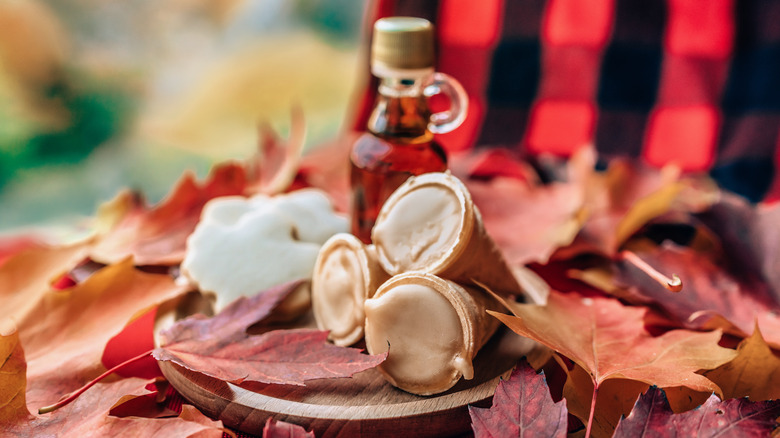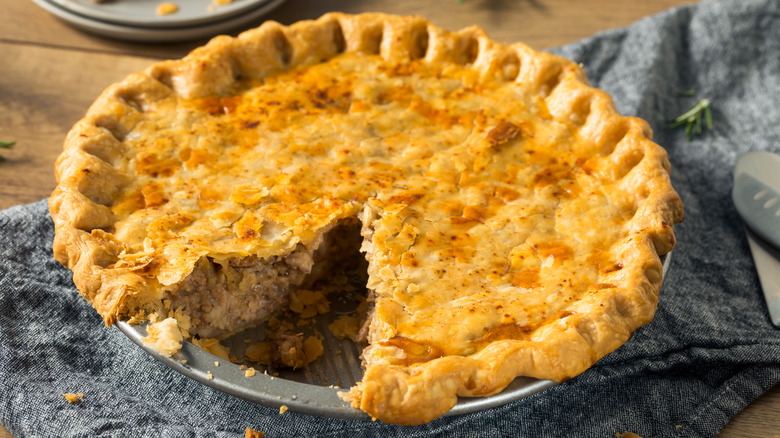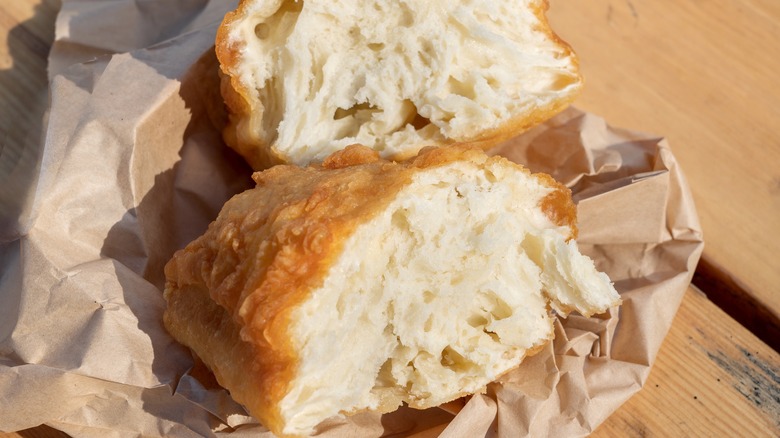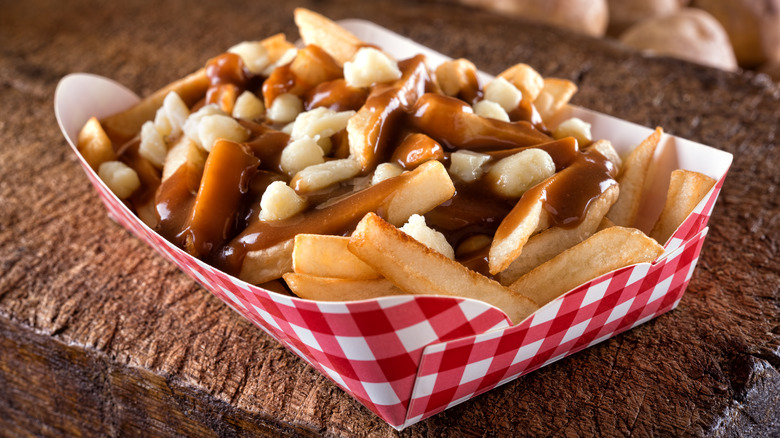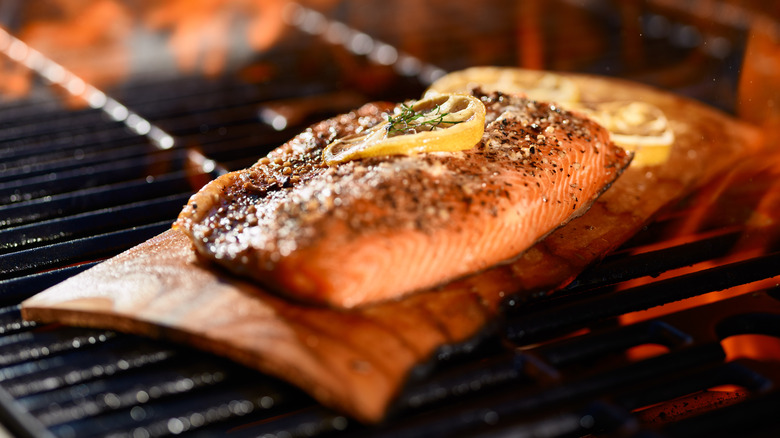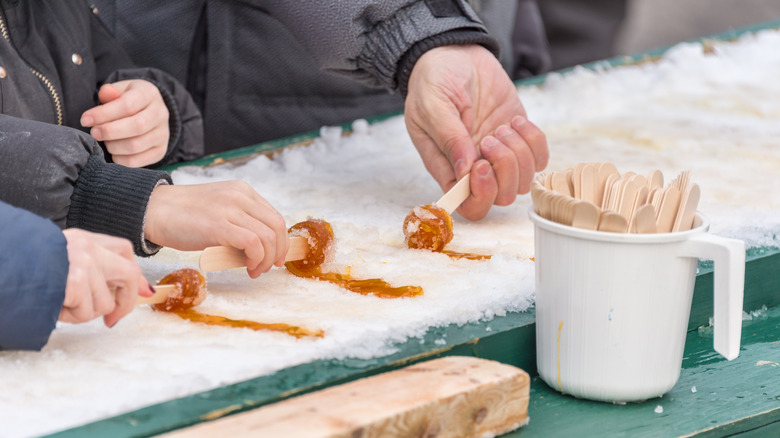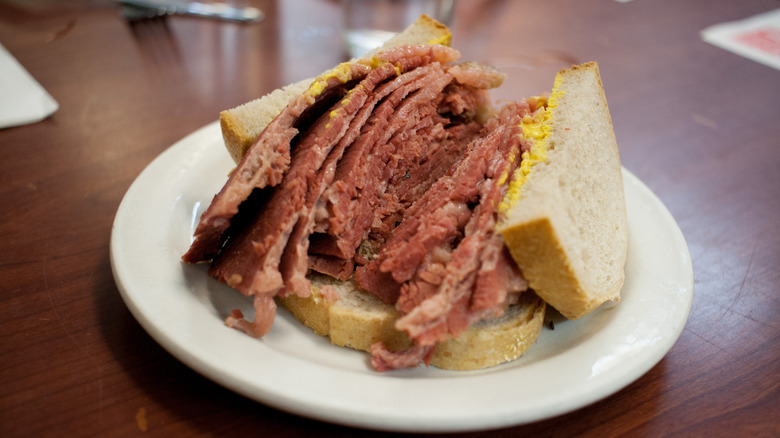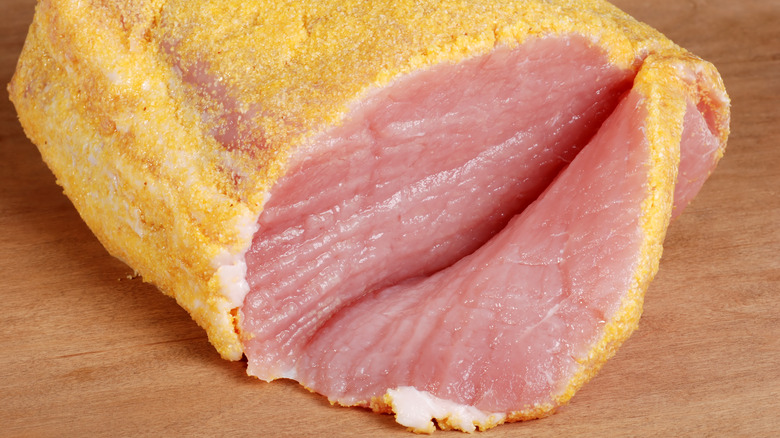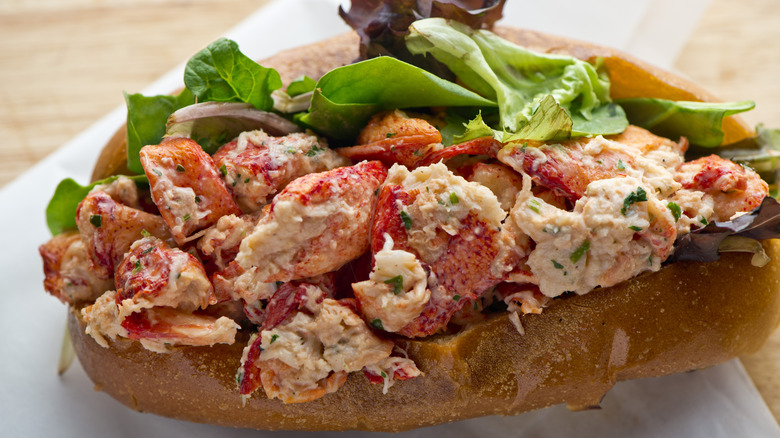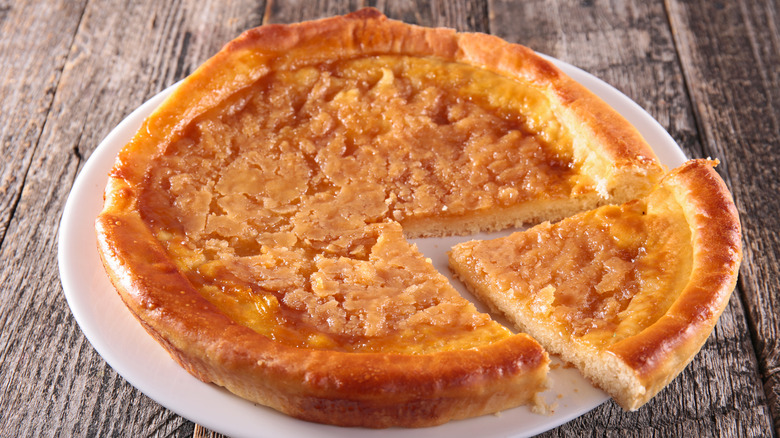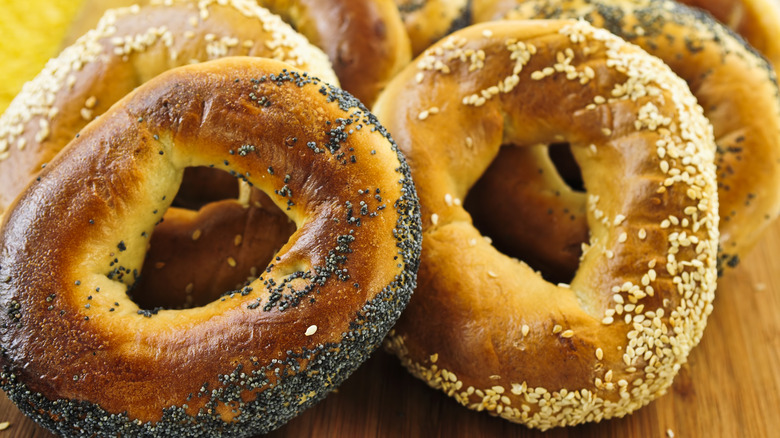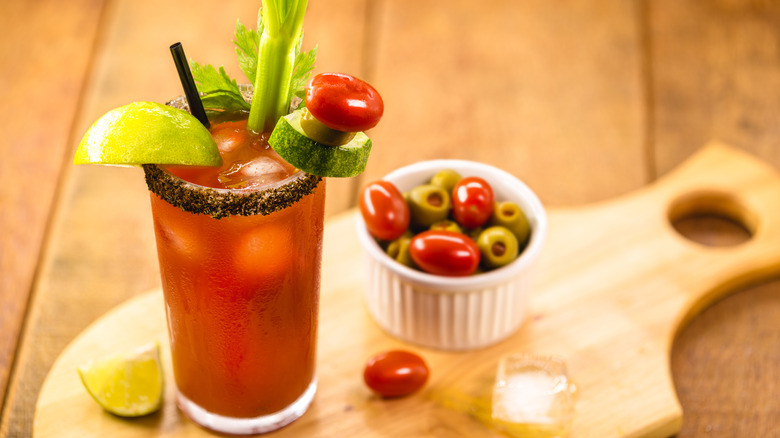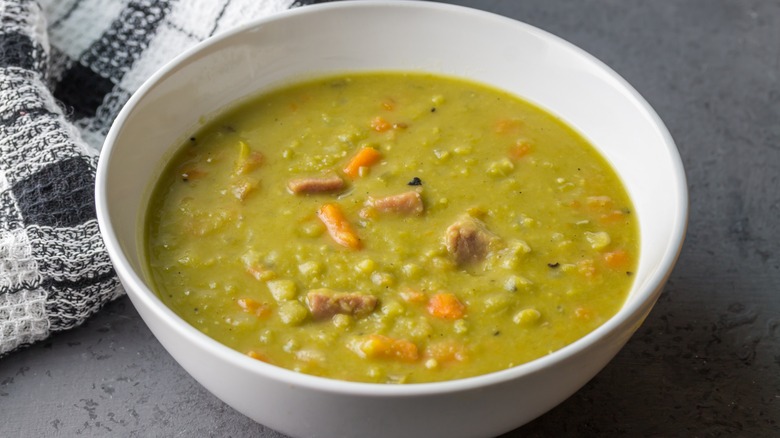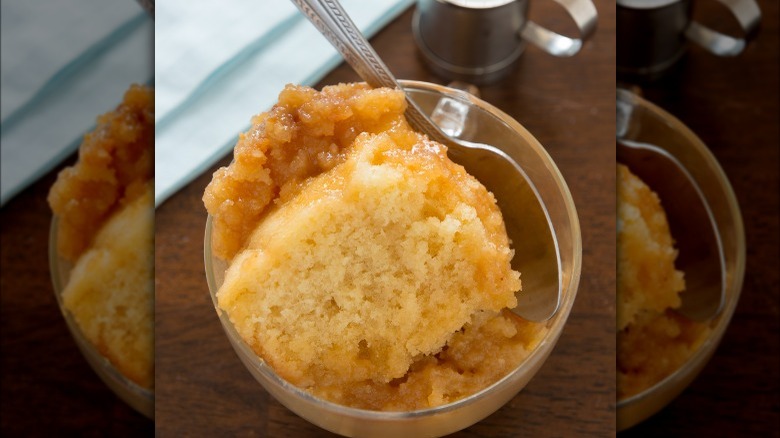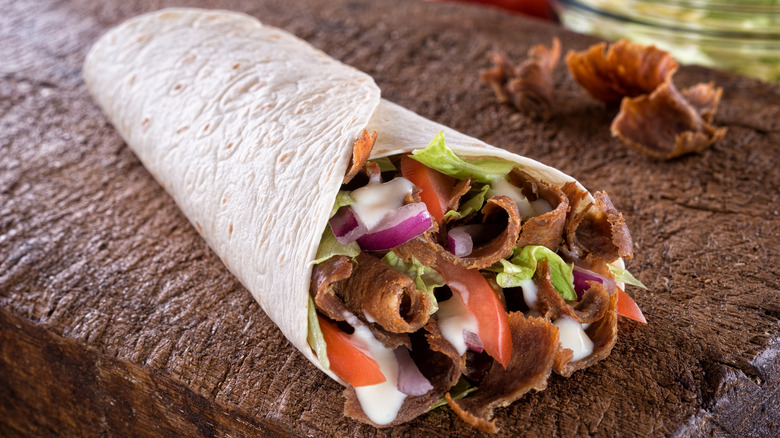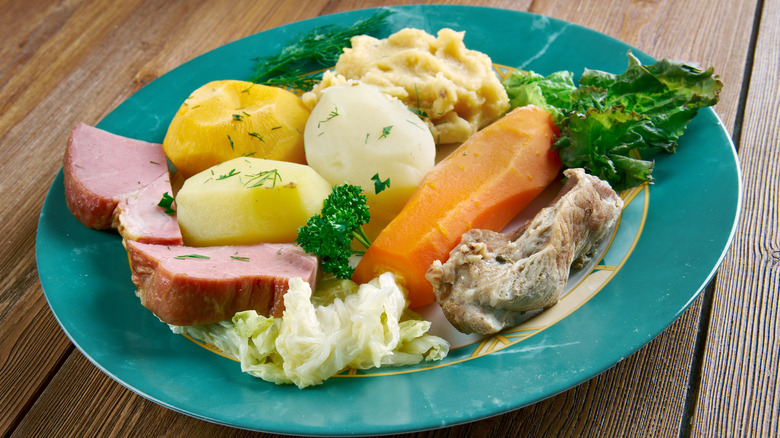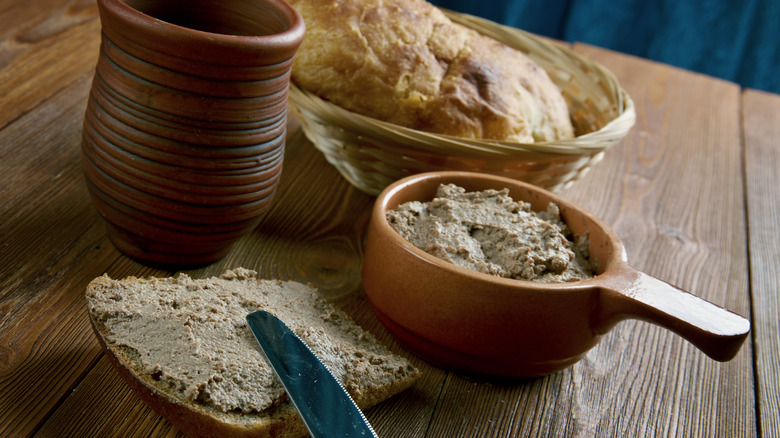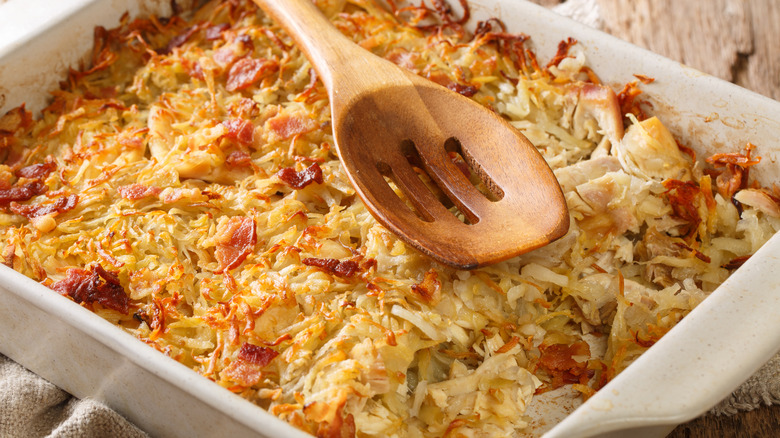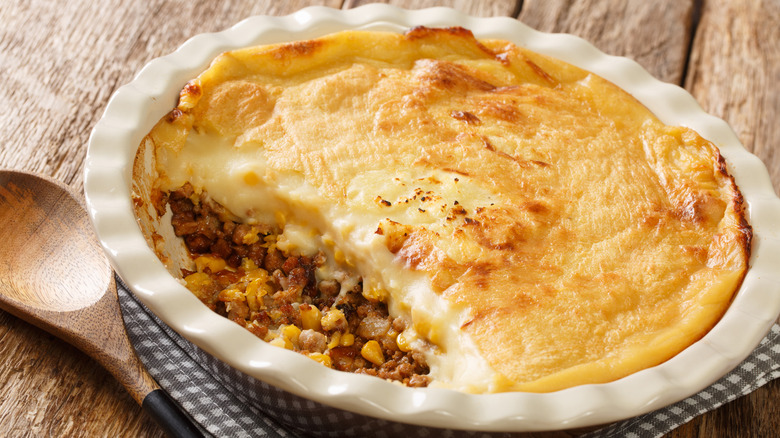25 Canadian Foods You Need To Try At Least Once In Your Lifetime
Although Canada shares a border with the U.S., our northern neighbor holds its own charm and traditions. While the experience of traveling there may not be as culturally diverse as crossing an ocean, thanks to its rich history of immigration, there's much more to it than meets the eye. As with any novel destination, discovering the intricacies of a place through its food is often the best way to dig into the deeper story.
Many Canadian dishes have roots in Europe due to the country's immigration patterns, but the various provinces have adapted and created countless recipes you'll be hard-pressed to find elsewhere. With a Pacific and Atlantic coast separated by thousands of miles of land, Canada has plenty to offer on the culinary front. From traditional meat and potato-based meals to fun bites with international buzz, your tastebuds are sure to be pleasantly surprised. Find out which Canadian foods you need to try at least once in your lifetime.
Tourtière
It doesn't get much more comforting than a meat pie ... unless you add potatoes to the filling. That pretty much sums up tourtière, a hearty French Canadian dish. With a flaky buttery crust base, ground or cubed meat, potatoes, a notable spice profile, and a golden crust lid. This hearty dish is best enjoyed in large gatherings, often around Christmastime.
The meat can be as basic as beef or as eclectic as assorted game meat such as rabbit or moose. Coastal versions might consist of salmon or trout, and secret family recipes are the norm. As for the spices, cinnamon, clove, allspice, and nutmeg are typically included. Tourtière is undoubtedly a labor of love, and though it's incredibly time-consuming to prepare, the results are worth it.
Bannock
Per Canada's 2021 census, almost 10% of the population identifies as Indigenous. This significant influence is evident in a number of dishes, and bannock is a notable example. While modern versions are usually made with wheat flour and either fried or baked, traditional bannock was first made with a North American plant called camas.
Canadian environmental studies professor Nancy Turner explains to CBC that the camas bulb itself was typically dried and shaped into dense loaves. Importantly, the starchy food kept well over time, which naturally led it to become a staple of the diet. What was once purely a source of sustenance has become a popular item, and Indigenous-run cafes selling bannock with an assortment of toppings are increasingly common across the country.
Poutine
If you know anything about Canadian food, poutine is undoubtedly on your radar. The gravy-laden mound of fries and cheese curds is a staple of late-night fast-food cravings. You're likely to find the dish across the country (even at local McDonald's and Burger King locations), but the heart and soul of poutine lie in the province of Quebec. Dairy farmers in the small town of Warwick first produced the squeaky cheese fundamental to the dish, Maclean's reports.
There are as many variations to the traditional recipe as your mind can imagine, though for the true experience, try the classic trio of ingredients at a greasy diner. If you want to experiment with a novelty version, you'll find recipes with foie gras, bolognese sauce, vegan cheese, and plenty more.
Cedar-plank salmon
Salmon has long been a favorite among seafood lovers worldwide, and it's certainly become easier to cook with modern kitchen appliances. However, for thousands of years, Indigenous people in coastal communities have enjoyed salmon, finding resourceful ways to prepare this fatty fish.
Cooking food over a fire is hardly novel, but populations in the Pacific Northwest started using a red cedar plank to protect the fish from the blaze (via NPR). The wood is first soaked, resulting in a smoky moist flavor-packed fish with a hint of cedar taste. Other types of wood planks can be used for grilling, but the First Nations & Indigenous Studies Department of the University of British Columbia highlights the importance of cedar in a multitude of facets of local Indigenous communities.
Maple taffy
Maple syrup isn't just for pouring on pancakes and waffles. The sweet and sticky treat known as maple taffy is made by boiling maple syrup until it is thick and concentrated Then, it's poured on a surface of fresh snow so that it slightly congeals. Finally, you press a wooden stick or spoon into one end of the maple concoction and roll it into a ball.
Per the name, the consistency is delightfully taffy-like, with a soft tackiness that makes it especially enjoyable. According to Les Trésors d'Érable, the sweet treat is popular in early spring when sugar shacks collect sap from maple trees to produce maple syrup. Look for maple taffy at ski hills, outdoor markets, and fairs, or make it yourself by heating maple syrup to a caramel consistency.
Smoked meat
Don't call it pastrami — Montreal smoked meat has its own identity. The specialty is an attraction for locals and tourists who line up outside iconic delis to bite into a simple sandwich of rye bread stacked high with smoked meat, a dab of mustard, and a pickle on the side. While the components are few, the flavor is anything but simple. A whole brisket is dry cured, seasoned with peppercorns, coriander, mustard seed, and garlic, and left to marinate.
The dish's origin story is murky, but Montreal Jewish Public Library archivist Eiran Harris explains that smoked meat likely came to Canada through Romanian Jewish immigrants in the late 1800s (via Érudit). With the influx of New York-style kosher delicatessens in Montreal, the savory dish soon became widespread.
Peameal bacon
Bacon is an easy sell for meat lovers, and while Canadian bacon is revered for its lean yet flavorful consistency, peameal bacon is a Canadian breakfast food you should know. Made from pork loin, the meat is wet-cured and coated in a cornmeal crust. The packaged product may be pre-sliced but it's typically not sold cooked or smoked.
Baked or roasted in the oven or grilled on the barbecue, peameal bacon has more in common with thinly sliced ham than with crispy bacon strips. The result is juicy, salty, and another great accompaniment to a plate of eggs and toast. Since the fat is trimmed away prior to curing the meat, peameal bacon is a leaner option if you're looking for a healthier breakfast alternative.
Butter tarts
You can't go wrong with something named a butter tart. Made with a flaky pastry and a filling consisting of sugar, egg, syrup, vanilla, and butter, the result practically melts in your mouth. Raisins can be added to the rich mixture, though the purest form is our favorite.
According to The Canadian Encyclopedia, the dessert spans the length of the vast country, and as with any widespread delicacy, its origin story is disputed. Some accounts place it in 20th-century Ontario where the first recipe was found, while others suggest it was introduced by French women who immigrated to Quebec in the 17th century. Still, Northern Ontario prides itself on being the home of the butter tart, celebrating the dessert with a yearly festival.
Lobster rolls
Sure you can get a solid lobster roll in New England, but the Atlantic specialty is at its prime in Canada's eastern Maritime provinces. According to Canadian Food Focus, lobsters were industrially fished in the 19th century, until they became a luxury indulgence after World War I. Traveling to the coastal provinces is an excuse to savor the local delicacies, and lobster rolls are a convenient and affordable format.
Nova Scotia went all out, creating its own Lobster Trail featuring the best spots to enjoy the dish. (You can also trust local McDonald's to offer lobster rolls.) While the specifics vary from spot to spot, the basic recipe consists of lobster meat, mayonnaise, lemon, chives, and celery or green onion mixed together and served in an artisanal hot dog bun.
Sugar pie
There's no quicker way to satisfy your sweet tooth than by eating a slice of sugar pie. The Quebecois treat was introduced by the first French settlers in the province and is a traditional element of holiday dinners. A flaky short crust is filled with a smooth mixture of heavy cream, maple syrup, butter, egg, and flour. The result is moist with a lightly crystallized top and surprisingly balanced given the rich ingredients.
Funnily enough, brown sugar was once scarce in the French province, hence the use of maple syrup due to the plentiful local supply. Nowadays, the substitution is often reversed in places where maple syrup is harder to come by. Still, the original is most evocative of the French-Canadian province.
Montreal bagels
The New York vs. Montreal great bagel debate continues to rage on, yet we will set aside disputes and focus on why the latter is so enjoyable. While you can get bagels across Canada, no city holds the starchy treat to heart quite like Montreal, where you'll find iconic bakeries battling it out for number one.
Introduced by Eastern European Jewish immigrants, local bagels are smaller than their American counterparts. The interior is subtly sweet from being dunked in hot honey water, and the bagels are finished in a wood-fired oven which makes the exterior pleasantly crunchy and chewy. Sesame seeds are classic, but poppy seeds or everything bagel topping are also common. Bite right into a warm bagel, or serve it with cream cheese.
Nanaimo bars
If you haven't examined a map of Canada's westernmost province, you'll be forgiven if you didn't know that Nanaimo is a city on Vancouver Island. More importantly, it's considered (at least by locals) to be the hometown of the sweet namesake bar. As with any iconic treat, variations are common, but the classic recipe consists of a coconut and graham crust layered with sweet custard and topped with chocolate ganache.
It offers the perfect textural contrast, but if you're not into layered bars, consider trying ice cream, fudge, cupcakes, and plenty more. Visitors to Nanaimo can taste their way through the city on the Nanaimo bar trail, enjoying the traditional style, twists to the original, or assorted desserts with the same flavor profile.
Caesar cocktail
Canadians drink Bloody Marys, but what really makes the rounds are Caesars, the cocktail with a fishy twist. At a quick glance, you might think the drink is a diluted Bloody Mary, but the foundational ingredient differs. Mott's Clamato juice is a clam broth-based beverage seasoned with tomato, spices, and sugar. Mixed with vodka, Worcestershire sauce, and hot sauce, Caesars often come garnished with extra snacks, making the drink that much more popular.
While the clam component might make some people squeamish, the ingredients combine so smoothly that it would be hard to single out. The New York Times spoke with a number of Canadians — some who actually travel with Clamato to guarantee their Caesar fix overseas — and the consensus was clear: Cocktails don't get more Canadian than the Caesar.
Ketchup chips
Potato chips vary from one place to another, with novelty flavors continuously released. However, ketchup chips are as Canadian as they come. In the 1970s, Ontario-based Hostess chip company set out to fill a gap in the crunchy chip market. While ketchup and fries are a classic combination, the brand realized that consumers couldn't enjoy the sweet, vinegary, and crunchy combo in a bag of chips.
So, it got to work producing ketchup in a powdered form, to bring the iconic pairing to a simple bag of chips. The company is now owned by Lay's, who still produces ketchup potato chips and ketchup Fritos Canada-wide. The numbers don't lie: Millions of bags of ketchup chips are sold every year, according to a PepsiCo spokesperson.
Split pea soup
Perhaps you're used to enjoying a hot bowl of split pea soup outside of Canada, but the Quebecois have been warming themselves up with the stuff for more than four centuries. Considering the province sees some of the chilliest temperatures in North America, it's no surprise a hearty soup made it to its top meals.
The ingredients are nourishing and keep well, which made it a meal of choice during long sea voyages. Dried yellow split peas, ham hock, vegetables, and thyme make up this wholesome dish. Served with bread, it instantly becomes a satiating meal with all your basic nutrient needs. Seek out a traditional bowl at a sugar shack, or pick up a canned version for a quick fix.
Saskatoon berry pie
It's hard to go wrong with pie, especially in the summer when fruits are plentiful. In Saskatoon, Saskatchewan, a namesake berry is at the heart of the city's favorite dessert. Saskatoon berries may not be easy to find, but the small subtly sweet earthy fruit is worth seeking out.
Surprisingly, the berries are actually a member of the rose family and have a bit of a bite to them. The fruit is one-of-a-kind, boasting a number of health benefits that have earned it a title as a superfood. Locally, people pick them off the plant as a snack, but baked goods are an obvious alternative. Saskatoon berry pie consists of a buttery flaky shell, containing a mixture of sweet stewed fruit.
Pouding chômeur
Many traditional dishes stem from the need to make something out of very little. Pouding chômeur (or "unemployed pudding") is a dessert that was reportedly created by women working in factories in late 1920s Quebec (via Maclean's). The simple ingredient list reflects this trying time, as the pudding consists of flour, butter, brown sugar, and milk.
Of course, as with many humble dishes, luxed-up variations are all too common. Nowadays, maple syrup, caramel, and other decadent add-ons are the norm in dining establishments that serve the classic dessert. Still, the heart of this sweet treat lies in the home, and this is one true comfort food that evokes nostalgia in anyone who enjoyed a family recipe for years.
Steamie
People tend to have serious opinions about their hot dog preferences, and in Montreal, steamies are the go-to. Forget about grill char marks on your bun, classic diners serve a basic wiener on a steamed white bun. A bit of yellow mustard, relish, and raw diced onions or cabbage are acceptable toppings, but it pretty much stops there.
The result is like a fluffy cloud wrapped around a juicy sausage with a textural crunch thanks to the toppings. It's perfect as a snack, or grab a couple and make it a meal. The diner favorite is so beloved that Montrealers have celebrated steamie week, with several days of pure hot dog gastronomy. On the flip side, other hot dog lovers opt for the toasty, made with a toasted bun.
Donair
Any street food lover will recognize doner kebabs or gyros, a Greek or Turkish flatbread wrap filled with shaved meat. While the birthplace of the traditional recipe is on the other side of the Atlantic, the city of Halifax, Nova Scotia, is home to its own rendition. The loaded wrap first came to Canada via Halifax, courtesy of a Greek immigrant, Peter Gamoulakos.
The Halifax donair consists of shaved beef (instead of traditional lamb), tomatoes, and onions. But it's the city's personal twist on the sauce that sets it apart from typical gyros. (Ingredients in the sweet and savory topping include condensed milk, sugar, garlic, and vinegar.) The wrap is increasingly served across the country, typically at establishments run by eastern Canadians.
Jiggs dinner
With its easterly location, the province of Newfoundland has a number of specialties you'll want to try on a visit. A Jiggs dinner is a one-plate-meal kind of food and consists of boiled or cooked components like meat, potatoes, and vegetables. Stacey Lastoe writes for Parts Unknown about one rendition she tried, with corned beef, a turkey leg, mashed potatoes, greens, cabbage, and a dark rich gravy to seal the deal.
Lastoe notes that boiled mixed vegetables were once more common when meat was harder to come by, highlighting some of the dish's adaptations. No matter the specifics, a Jiggs dinner requires lengthy preparation and is best enjoyed with a boisterous group of family and friends. The hearty meal sure sticks to the bones, making it perfect for frigid coastal Atlantic winters.
Cretons
The fact that creton producer Marc Mailhot describes the spread as "Canadian peanut butter" to NPR has the potential to be misleading for fans of the latter. However, the ubiquity of cretons in the country's French-speaking areas in the east makes the comparison more relevant. Regardless, cretons is a pork pâté typically spread on crackers or bread.
The pork is browned along with onions and seasoned with spices (cinnamon, allspice, and cloves are common). The meat is then simmered with milk and occasionally breadcrumbs. When the meat is fully cooked, it is ground into a paste, aka cretons. The hearty spread is traditionally served on toast for breakfast or as a hearty sandwich filling with mustard. Add it to a charcuterie board alongside other pâtés for a Quebecois twist.
Rappie pie
Amidst Canada's multicultural profile, Acadian culture stands out in the Maritime provinces, for its unique traditions and practices. Of course, the Francophone community's culinary influences are of notable interest, and rappie pie is a crowd favorite. As it turns out, the dish was originally developed out of the need to make something nourishing from the lowly potato fields left to the Acadian population.
Food Bloggers of Canada explains that the first renditions were made with 20 pounds of potatoes to serve around 15 people. More importantly for the person making the dish, the potatoes are all grated which makes this a fairly time-consuming preparation — especially in large volumes. The spuds are baked in a casserole with stock, chicken, and pork, turning into a thick and hearty meal.
Pizza-ghetti
Pizza or pasta is a pretty common question when a craving for Italian food strikes, so in Quebec, the two are simply combined into one dish: pizza-ghetti. Carb overload? Sure. Delicious? Absolutely. While you won't find the specialty at Italian restaurants across the province, this comfort food is a staple in casse-croûtes, aka local diners.
As Melissa Como writes for Vice, this meal hasn't been the focus of gourmet foodie trends, and it pretty much sticks to the two foundational components. You'll typically get a serving of spaghetti nestled beside two pizza slices, but some spots are known to serve the pasta baked into the pizza topping. While it takes a certain place (and mood) for it to sit just right, pizza-ghetti is easy to love.
Pâté chinois
This hearty meat and potato dish is thought to be based on British shepherd's pie, but the Quebec rendition has its own twist. For starters, although the dish comes from the French province, its name (Chinese pie) is thought to allude to the fact that Chinese rail workers created the particular recipe, as Global News reports. However, the outlet points out that even among pâté chinois experts, the recipe's actual origin is unknown.
In the Canadian version, a ground beef and onion base is topped with creamed corn, then loaded up with mashed potatoes. The casserole is typically broiled at the end, leaving diners with a thin crunchy layer over the creamy contents. Add a squirt of ketchup for a sweet and tangy burst of flavor.
Beaver Tails
If you're not familiar with this decadent dessert, you might be aghast that Canadians actually eat those cute and furry (albeit damaging) animals. But don't take the name literally. While we can't vouch for the entire country's eating habits, if someone offers you a Beaver Tail, just say yes.
Similar to what's known as elephant ears elsewhere (what is it with the animal parts?), these are simply flat pieces of fried dough. The result is crispy and chewy and endlessly customizable. Toppings can get really funky and pretty much anything sweet goes: whipped cream, syrup, chocolate sauce, peanut butter, cinnamon sugar, fruit, and the list goes on. Although you can get similar fried dough desserts at other locations, the Beaver Tail company is the only one to make the specific rendition.
